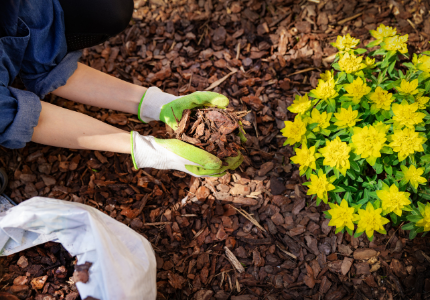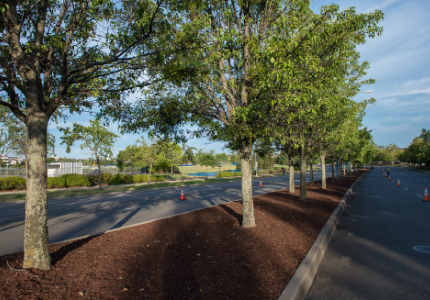Construction and Landscaping
Construction and demolition (C&D) activities generate a significant amount of wood waste. Repurposing construction debris prevents wasteful decay in landfills, where it converts into methane, a greenhouse gas that contributes to climate change.
Non-hazardous lumber waste can be reused or recycled into new products, such as reused building materials, mulch, and compost, which help conserve our limited water supply and other resources.

Overview of Requirements
Existing state law and regulations already require jurisdictions to adopt the California Green Building Standards Code (CCR, Title 24, Part 11 – CALGreen) and the Model Water Efficient Landscape Ordinance (CCR, Title 23, Division 2, Chapter 2.7 – MWELO).
To support California’s efforts to reduce emissions of short-lived climate pollutants, jurisdictions must adopt an ordinance or other enforceable measure that requires compliance with specific sections of CALGreen and MWELO. CalRecycle’s Model Enforcement Ordinance offers customizable language structured to fulfill these SB 1383 requirements.
Article 8 of the SLCP Regulations refers to the CALGreen and MWELO requirements. For these requirements, a jurisdiction is defined as “a city, a county, or a city and county”. The requirements do not apply to special districts that provide solid waste collection.
SB 1383 and CALGreen
Construction Waste Diversion
- Jurisdictions are already required to adopt CALGreen, sections 4.408.1 and 5.408 in their municipal code. Projects requiring local construction permits must divert at least 65% of the C&D materials generated at the project site from landfills.
- The SB 1383 regulations require jurisdictions to have a mechanism to enforce CALGreen’s 65% C&D debris recovery rate requirement. This ensures the maximum amount of organic waste commingled with C&D debris is recovered from building projects in the state.
- CALGreen applies to various occupancies and building types. Refer to the summary table and FAQ for more information on CALGreen’s waste diversion requirements.

Space for Organics Collection
- Jurisdictions are already required to adopt CALGreen, sections 4.410.2 and 5.410.1 in their municipal code.
- It requires providing readily accessible areas that serve the entire building for depositing, storage, and collection of non-hazardous materials for recycling, including paper, corrugated cardboard, and other organic waste.
- This applies to:
- Newly constructed non-residential buildings
- Certain non-residential additions and
- Multi-family housing with ≥ 5 units
- This applies to:
- The regulations require jurisdictions to enforce this space allocation guideline, ensuring that the maximum amount of organic waste is recovered from multifamily residential and non-residential building occupants.
- It requires providing readily accessible areas that serve the entire building for depositing, storage, and collection of non-hazardous materials for recycling, including paper, corrugated cardboard, and other organic waste.
Reporting
In its annual report to CalRecycle, each jurisdiction must provide the number of C&D debris removal activities that complied with CALGreen’s minimum 65% C&D debris recovery rate requirement.
For more information on CALGreen, refer to the Building Standards Commission’s website.
SB 1383 and MWELO
Soil Amendment, Compost, and Mulch
- Jurisdictions are already required to adopt the MWELO, 493.2(d)(2), (3), (4), and (7) in their municipal code. It applies to certain landscape projects (section 490.1).
- The regulations require jurisdictions to have a mechanism by which to enforce:
- The incorporation of soil amendments when planting
- Use of compost for landscape installations with a minimum of four cubic yards per 1,000 square feet and a depth of six inches and
- Application of a minimum three-inch layer of mulch for planting areas.

Post-Consumer Organic Mulch Products
- Jurisdictions are already required to adopt the MWELO, section 493.2(d)(7) in their municipal code. It instructs covered landscape projects to use organic mulch materials made from recycled or post-consumer goods over inorganic materials or virgin forest products.
- The SB 1383 regulations require that jurisdictions enforce existing requirements regarding the preferential use of recycled and post-consumer organic mulch materials.
- Using recycled and post-consumer compost and mulch materials may be an opportunity for the jurisdiction to help meet its SB 1383 procurement target.
- For example: A landscaper could act as a direct service provider and procure compost and mulch on behalf of the jurisdiction, provided all procurement requirements are met.
- For more information on procurement and product eligibility, visit the Procurement webpage.

Reporting
In its annual report to CalRecycle, each jurisdiction must provide the number of landscaping projects subject to the MWELO, 493.2(d)(2), (3), (4), and (7).
For more information on MWELO, refer to the California Department of Water Resources’ website.
Resources for Implementation
CalRecycle developed the following SB 1383 tools to assist jurisdictions successfully implement and enforce CALGreen and MWELO.
- Model Enforcement Ordinance – Sections 13 and 14 provide customizable language structured to fulfill SB 1383’s CALGreen and MWELO requirements.
- Model C&D Ordinance – This tool helps jurisdictions develop an ordinance that best fits their needs and conditions. It includes enforcement mechanisms such as deposits, fines, and penalties.
- SB 1383 Local Service Rates Analysis – Appendix E contains Model Waste Enclosure Guidelines to assess the sufficiency of service and space at generator sites for garbage, recycling, and organics service.
- SB 1383 Collections Frequently Asked Questions specific to CALGreen and MWELO

For more information contact: Short-Lived Climate Pollutants (SLCP), Organic Waste Methane Emissions Reductions, SLCP.Organics@calrecycle.ca.gov
